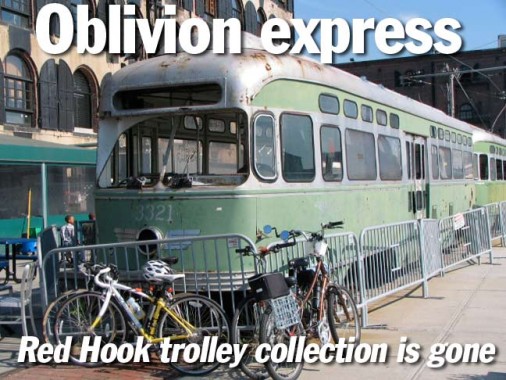There’s one less reason for me to visit Red Hook. On February 9, 2014, the collection of trolley cars that Bob Diamond, the rediscoverer of the Atlantic Avenue Tunnel, had assembled in a scotched attempt to bring trolley service back to the streets of Brooklyn, were trucked away from the tracks behind the Fairway Supermarket (originally the Van Brunt Stores building) on Beard Street where they had been parked for the greater part of the last decade since the trolley project fell through.

(photos from the summer 2010)
Apparently the owner of much of the warehouses and property in this stretch, Greg O’Connell, tired of seeing the rusted hulks along the waterfront, where they had been open to the harsh winds and salt air and water of the Upper New York Bay.
A little background is in order here.
There was a Jurassic Park-like experiment that went on in remote Red Hook, Brooklyn, where a Flatbush resident named Bob Diamond dreamt of returning trolley cars to their rightful place on the streets of Brooklyn, where they ran for the greater part of the 20th Century. In the movie Jurassic Park, Richard Attenborough cloned some dino DNA found in an amber-preserved insect, and bingo, a flock of man-eating lizards appeared. Diamond has acquired some trolley DNA in the form an 1897 model from F. Schuckert & Co., built in Nürnberg, Germany, and used in the Oslo, Norway trolley system for many years (and even served as the king’s private car for a time, three 1951 PCC cars that ran on Boston’s Green Line for decades, a switching locomotive, and twelve trolley cars from Ohio. He intended they rid the waterfront streets of auto traffic the way the dinos got rid of hapless villains and extras in the movie.

In 2003, the City pulled the plug on Diamond’s dream. The Department of Transportation insisted that Bob acquire independent funding for the project; so far he has been unable to raise enough money to continue, but he still had the trolley cars, and so his dream wasn’t completely dead.
After discovering an abandoned LIRR tunnel under Atlantic Avenue in the early 1980s, Diamond set in motion a process that he hoped would someday bring trolley service from Red Hook to Brooklyn Heights. He acquired space in the venerable Beard Street Warehouse where he formed the Brooklyn Historic Trolley Association and worked night and day on revitalizing the ancient cars; he had hoped to open the space for a trolley museum, construct trackage from Red Hook along Columbia and Furman Streets to the new waterfront park being constructed there, and perhaps even return the Atlantic Avenue tunnel to revenue service.
For a couple of years, things progressed steadily, as Diamond constructed trackage in a loop along the waterfront running west from the warehouse, and then along Conover, Reed and Van Brunt Streets. The PCC cars and the magnificent brown and gold Schuckert clanged along the waterfront as tourists marveled.
Diamond had disputes with former volunteers on his team, was evicted from the warehouse after occupying the space rent-free for almost 10 years, and the city grew tired of waiting for Bob to raise funds. At length, the City dropped support for the project, and finally, the Department of Transportation came in and ripped up the tracks and paved the streets in early 2004. But the tracks along the waterfront, catenary wire and poles, and trolley cars, covered in canvas to protect them from the elements, still remained at the waterfront.
The tracks and catenary are still in place and are all that is now left of Diamond’s quixotic quest. Reports vary about where the trolley cars were taken to. Some say they’ll be trashed for scrap. Diamond is hopeful that they will go to the Trolley Museum of New York.
Oh, and the Schuckert was vandalized some time back.
It’s one more example of New York City’s edges being smoothed out.
UPDATE: the trolleys were donated to the Branford Electric Railway Association which operates the Shore Line Trolley Museum in East Haven, CT; however, Diamond maintains the trolleys were not McConnell’s to donate.
2/13 UPDATE: the cars are so far gone that BERA thinks they may have to be scrapped.
2/10/14
